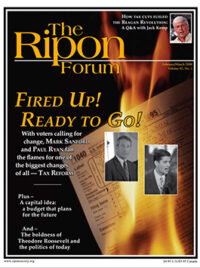As signs of economic weakness appeared in January 2008, the White House and House Leaders agreed to a $150 billion stimulus package based on rebates to taxpayers and tax incentives for businesses.
While the Senate has yet to sign-off on this package, one thing is certain – using fiscal policy in the manner being proposed is both imprudent and counterproductive. It adds to the current deficit without putting in place any plan for repayment, and it places too much emphasis on private consumption and investment to boost economic activity.
No doubt some sort of stimulus plan is going to be approved. There is also little doubt that, at some point in the future, there will be another economic slowdown, and the White House and Congress will likely consider again some sort of package to spur things along. Some important changes to our budget policy should be made before then – changes that will help produce a better stimulus package the next time one is needed.
These changes must begin with an honest assessment. Indeed, in order to use fiscal policy constructively to smooth out business cycle fluctuations, we need to honestly assess our current economic and policy challenges and tailor our fiscal policy interventions to meet them. The agreement reached by the House and White House in January addressed two problems that the United States does not have.
First, the nation does not have an underconsumption problem. The personal saving rate hovers around zero. The government’s budget has been in surplus in only four of the last 35 years. The nation has run current account deficits with the rest of the world for the last 15 years. If we are looking for additional economic activity, consumption is a poor choice.

Where our country does have an under-investment problem is in our public infrastructure
Second, we do not have an underinvestment problem in the private sector. Interest rates have been very low by historical standards, and the Federal Reserve intervened immediately to lower them even further. With or without additional tax-based incentives, corporations have plenty of access to cheap credit to expand their capital stocks.
Where our country does have an underinvestment problem is in our public infrastructure. The failed levees of New Orleans. The collapsed bridge in Minneapolis. Those are but two recent examples of an area where the federal government is falling down on the job. Regrettably, they are not the only examples. In 2005, the American Society of Civil Engineers released a report card in which it estimated that $1.6 trillion would be required over a five-year period to restore the nation’s physical infrastructure to good condition.
Because infrastructure projects are in many cases public goods or natural monopolies that can be provided more efficiently with government regulation or implementation, the government should bear responsibility for them. Looking ahead, the country faces potential bottlenecks in network infrastructures in broadband and alternative energy that could be added to the ASCE report’s recommendations.
To be sure, there was some discussion of issuing debt to finance more public works projects during January. But under the urgency to generate a stimulus package that was “timely, temporary, and targeted,” capital projects were discouraged. Despite the availability of the ASCE report card and the high profile failures in New Orleans and Minneapolis, the federal government has not recognized its need to include capital projects in its budget.
The idea of a formal capital budget is a recurring theme in Washington, and was the focus of a Presidential Commission in 1997. A detailed capital budget is an interesting academic exercise, but it is not necessary here. All that is required is to recognize the backlog of critical public infrastructure needs, to convene a group of experts and policy makers to prioritize them, and to schedule them for implementation over a multi-year horizon. When economic growth falters, the federal government would be in a position to move some of the projects from later years into the present year and avoid the downturn.
All additions to this year’s deficit are “paid for” in some way. The consumption and private investment spurred by the debt issued as part of the January 2008 stimulus package will be repaid at some point in the future or serviced through higher interest payments in all years in the future. Current taxpayers get all the benefits, while future taxpayers bear all of the costs. Since only current taxpayers vote, it is easy to understand the bias toward deficits in our democracy.
We could increase the fairness of our budget policy by adopting a target of balancing the budget over a complete business cycle. This commitment would not preclude the January 2008 agreement, but it would require that the debt be repaid fairly quickly, when the economy has recovered, thereby aligning the costs and benefits of the policy across cohorts of taxpayers.
As long as the costs of infrastructure projects are included in the multi-year projections of the federal budget, using capital expenditures to stimulate the economy abides by this target. Projects moved forward by a year would increase the deficit in 2008 but reduce it in 2009, when an economy that was thought to need temporary stimulus will have regained its footing. Overall expenditures should also fall through this counter-cyclical policy, since prices are lower in periods of economic slack.
With these minor modifications — a prioritized and budgeted agenda of public infrastructure projects and a budget target that achieves balance over a complete business cycle — we can use fiscal policy effectively to both combat short-term economic fluctuations and rebuild critical infrastructure that has itself become a drag on our long term economic well-being.
Andrew A. Samwick is the Director of the Nelson A. Rockefeller Center at Dartmouth College. He previously served as the chief economist on the staff of the President’s Council of Economic Advisers.




